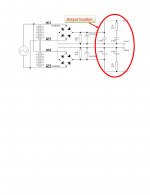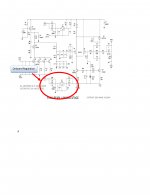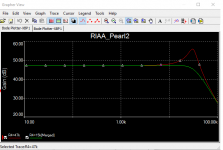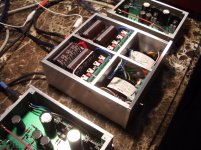Snubbers: The leakage inductance of the trafo AND the capacitance of the rectifier diodes creates a resonant "tank" circuit which can, under certain circumstances, cause PN junctions to conduct when they otherwise wouldn't.
Snubbers in audio circuits have been flogged to death, employed without any knowledge of the parasitic inductance of the transformer or capacitance of the rectifying diodes.
There's a real, existential need for a snubber in an SMPS power supplies. Elsewise measure first, listen, and report back.
Snubbers in audio circuits have been flogged to death, employed without any knowledge of the parasitic inductance of the transformer or capacitance of the rectifying diodes.
There's a real, existential need for a snubber in an SMPS power supplies. Elsewise measure first, listen, and report back.
I am in the process of getting all the parts to build a Pearl 2.
I have a couple of questions.
First the cartridge loading resistor. I am using a Kiseki purpleheart cartridge. It has an output of 0.4mV and an impedance of 6R.
What value of cartridge loading resistance would you suggest?
Second, will I still need to use a SUT with the Pearl 2? In my current setup I am using a Bob's devices SUT (30dB gain) with a Bottlehead Eros which has 50dB of gain
Thanks
Debra
I have a couple of questions.
First the cartridge loading resistor. I am using a Kiseki purpleheart cartridge. It has an output of 0.4mV and an impedance of 6R.
What value of cartridge loading resistance would you suggest?
Second, will I still need to use a SUT with the Pearl 2? In my current setup I am using a Bob's devices SUT (30dB gain) with a Bottlehead Eros which has 50dB of gain
Thanks
Debra
Debra! Great to see you here in this thread. 😀
Load - well, that depends on if you are using the SUT or not...
If you directly run the cartridge to the Pearl, then I'd start at 1K or so. Adjust to taste.
If you use the SUT, then at the Pearl inputs you need to load the transformer, not the cartridge, so just use the regular 47K. (The Bob's transformers are expecting to 47K on the secondary.)
Try both ways, but I bet you'll prefer the sound with the SUT.
Order a couple extra ZVP3310, they are VERY static sensitive, and about 1/2 the builders zap one or two during the build, and it's easier to have spares on hand right away.
Load - well, that depends on if you are using the SUT or not...
If you directly run the cartridge to the Pearl, then I'd start at 1K or so. Adjust to taste.
If you use the SUT, then at the Pearl inputs you need to load the transformer, not the cartridge, so just use the regular 47K. (The Bob's transformers are expecting to 47K on the secondary.)
Try both ways, but I bet you'll prefer the sound with the SUT.
Order a couple extra ZVP3310, they are VERY static sensitive, and about 1/2 the builders zap one or two during the build, and it's easier to have spares on hand right away.
I am in the process of getting all the parts to build a Pearl 2.
I have a couple of questions.
First the cartridge loading resistor. I am using a Kiseki purpleheart cartridge. It has an output of 0.4mV and an impedance of 6R.
What value of cartridge loading resistance would you suggest?
Second, will I still need to use a SUT with the Pearl 2? In my current setup I am using a Bob's devices SUT (30dB gain) with a Bottlehead Eros which has 50dB of gain
Thanks
Debra
Your two questions are interconnected.
Cartridge loading:
It is often recommended to load at least at ten times the internal impedance. So I'd try with 100ohms at first.
With your current set-up, the load with your 30 dB SUT (1:29.5 ratio) is 54 ohms (47000/29.5²). So, if your happy with it, you can try that.
I f I were you, I'd buy several values (50, 100, 200, 400 ohms) and choose by ears once the Pearl is finished.
Gain:
If you really need the 80dB gain of your current set-up, certainly the 55dB (or 65dB) Pearl 2 will be a little "weak". You will have 711mV output (with 65dB) instead of 4000mV (which is really huge).
On the other side, maybe less gain in the phono stage will give a more usable volume control in your setup.
If you want to try the SUT with the Pearl 2, buy a 47k input resistor in addition to the other I listed above.
gigigirl, the raw PSU for the Pearl 1 is different. It also is pretty tolerant of being simple as the Pearl 1 has onboard regulators. But a Pearl 2 supply won't work.
What kind of noise? Hum or white noise?
Can you post a few photos of the guts of the PSU and Pearl?
What kind of noise? Hum or white noise?
Can you post a few photos of the guts of the PSU and Pearl?
If it's hum, I'd suspect faulty grounding instead of PSU.
Start a new thread or we can figure it out here, either way is fine. 😀
We will need photos however... 🙂 🙂 🙂 particularly of the pearl boards
Start a new thread or we can figure it out here, either way is fine. 😀
We will need photos however... 🙂 🙂 🙂 particularly of the pearl boards
I've been working on all the power supplies in my Pass/FirstWatt components and have finally gotten to my Pearl II supply (I'm working on installing input snubbers).
The supply for the Pearl II incorporates a board from Chipamp.com which has onboard output snubbers. When I originally built the supply I populated the boards with the snubber parts. It occurred to me that I really didn't need these parts, so while I had it apart I pulled them out. I put the supply back together because my brother was coming over and we were going to "spin some tunes", so there are no other changes to the supply.
When I put the Pearl II back in the system I had no expectation of a sonic difference so I was really caught by surprise because there's a huge difference, this thing sounds way different. Not a subtle difference, but a two grooves in jaw hitting the floor kind of difference.
Can somebody explain to me what in the world is going on here?
Sorry I didn't post schematics originally, it took me this long to figure out how mark them up.
I would like to pursue this a little farther. Still trying to get my head around how removing these parts could make such a dramatic difference in sound.
I appreciate the information about the PN junction conducting, I'm reading about that. Still, it seems like there could be more to it. Could the output snubber somehow be reacting with the onboard regulation?


Other than "PSU snubbers stink" I can't offer any reason why the difference would be so dramatic, however I'm not surprised.
If you want to get all science-y, you can replace the fixed 1 ohm resistor with an adjustable resistor (a potentiometer) and then find the resistance setting which results in the GREATEST sonic difference between [red "Output Snubber" = YES] and [red "Output Snubber" = NO]. Possibly DigiKey part # CT2150-ND might be a good choice. It's a 5 ohm, 5 watt device, giving you plenty of adjustment range.
Once you have dialled in the MAXIMUM SONIC DIFFERENCE value of snubbing resistance, it's time to start snapping lots and lots of oscilloscope photos. What, if anything, is different on the oscilloscope between [red "Output Snubber" = YES] and [red "Output Snubber" = NO]??
Once you have dialled in the MAXIMUM SONIC DIFFERENCE value of snubbing resistance, it's time to start snapping lots and lots of oscilloscope photos. What, if anything, is different on the oscilloscope between [red "Output Snubber" = YES] and [red "Output Snubber" = NO]??
Mark was probably too modest to promote his own thread, but this is awesomely useful! http://www.diyaudio.com/forums/powe...sformer-snubber-using-quasimodo-test-jig.html
Mark was probably too modest to promote his own thread, but this is awesomely useful! http://www.diyaudio.com/forums/powe...sformer-snubber-using-quasimodo-test-jig.html
I know! This is cool too: http://www.diyaudio.com/forums/powe...dirty-transformer-snubber-bellringer-jig.html
I started stuffing my Pearl2 pcbs yesterday and I have a question concerning P1. IIRC, when I built my Aleph J, there was a trimpot that needed to be set at a particular value before soldering it (I think it was the middle value).
Should I do the same thing with P1 (ie set it at 2.5kOhms)?
Should I do the same thing with P1 (ie set it at 2.5kOhms)?
If you use the SUT, then at the Pearl inputs you need to load the transformer, not the cartridge, so just use the regular 47K. (The Bob's transformers are expecting to 47K on the secondary.)
47k may not load correctly.
For the correct load disconnect the first stage from the RIAA network. If you don't have an analyzer which goes out to 100kHz you can use a 10mV square wave @1kHz and observe the ringing on the leading edge on a scope. Just like Goldilocks, not to hot and not too cold.
Attachments
What are the advantages of using a R-core transformer.
I have both a 22V+22V toroid and a 25V+25V R-core avaialbe for use in the project
Debra
I have both a 22V+22V toroid and a 25V+25V R-core avaialbe for use in the project
Debra
In my experience, R-cores hummmmmmm. I'd avoid them.
YMMV. If you've got the 22V toroid, might as well use it. Also fewer volts will be dissipated as heat in the regulators with the 22v.
YMMV. If you've got the 22V toroid, might as well use it. Also fewer volts will be dissipated as heat in the regulators with the 22v.
No. And also you can try add 400uF cap in series with R14 and in this case you do not need P1, just short it and replace R6 by 2.2 K.Should I do the same thing with P1 (ie set it at 2.5kOhms)?
- Home
- Amplifiers
- Pass Labs
- Building a Pearl 2

